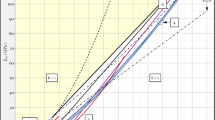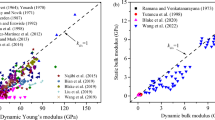Conclusions
-
1.
The modulus of elasticity and the shear modulus, as found by the dynamic method, are objective properties of the rock and are independent of the experimental conditions and the characteristics of the apparatus.
-
2.
Dynamic methods of determining the elastic properties of a rock have advantages over static methods: they are easier and simpler to use, more accurate, preserve the rock specimen, and can be used in a mine.
-
3.
The dynamically measured elastic characteristics of a rock can be used as parameters for the solution of problems in rock pressure and rock fracture.
Similar content being viewed by others
Literature Cited
Methods of Laboratory Determination of the Indices of Static Elasticity of Rocks, Leningrad, Izd. VNIMI (1961).
K. V. Ruppeneit, Mechanical Properties of Rocks, Moscow, Ugletekhizdat (1956).
B. P. Belikov, Elastic and Strength Properties of Rocks. Proc. of Institute of Geology of Ore Deposits, Petrography, Mineralogy, and Geochemistry, Moscow, Izd. AN SSSR (1961), issue 43.
O. I. Silaeva, Use of Ultrasound to Study the Velocities of Propagation of Elastic Waves and the Elastic Parameters of Rock Specimens under Uniaxial Pressure, Tr. In-ta fiziki Zemli im. O. Yu. Shmidta, Moscow, Izd. AN SSSR (1962), No. 27.
V. I. Emelin and I. S. Chuprov, Experience in the Use of Ultrasound to Determine the Dynamic Elastic parameters of Rocks in Field Conditions, Izv. AN SSSR, seriya geofiz. (1962) No. 4.
L. Knopoff, On Rayleigh Wave Velocities, Bull. Seismol. Amer., 42 (1952), No. 4.
V. A. Romanov, Theory of Errors and the Method of Least Squares, Moscow-Khar'kov, Ugletekhizdat (1962).
I. S. Berzon, High-Frequency Seismics, Moscow, Izd. AN SSSR (1957).
L. I. Baron and V. M. Kurbatov, On the Index of Relative Brittleness of a Rock, Izv. AN SSSR, OTN, Metallurgiya i toplivo (1959), No. 4.
Author information
Authors and Affiliations
Additional information
zsranslated from Fiziko-Tekhnicheskie Problemy Razrabotki Poleznykh Iskopaemykh, No. 2, pp. 45–53, March–April, 1966.
Rights and permissions
About this article
Cite this article
Turchaninov, I.A., Panin, V.I. Comparative assessment of the dynamic and static methods of determining the elastic properties of rocks. Soviet Mining Science 2, 148–154 (1966). https://doi.org/10.1007/BF02497752
Received:
Published:
Issue Date:
DOI: https://doi.org/10.1007/BF02497752




